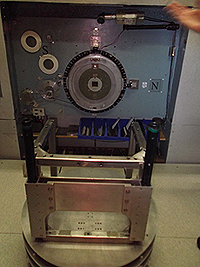Linac Restarts, Beams Back Up for Cancer Treatment

Patients can receive high-energy neutron beam therapy for certain types of cancer at Fermilab’s Neutron Therapy Facility. The treatment involves positioning the patient in front of the beam port. A beam of neutrons is sent through the opening in the center, targeting the cancerous tissue. Photo: Jessica Orwig.
Amid the forest of wires and machines in Fermilab’s Linac Gallery is a small, windowless room accessible only through a sliding steel door. With wood-paneled walls and a couple of white, synthetic orchids in full bloom, the room seems like it belongs in a home and not among the complex technology of a national accelerator laboratory.
Yet the room, part of Fermilab’s Neutron Therapy Facility, would not exist without the lab’s linear accelerator since it is a place where patients with certain types of cancer go for high-energy neutron treatments. Once a patient is inside, the entire room descends four feet, revealing a baseball-sized opening in the wall through which neutrons travel.
When the Cockcroft-Walton generators went offline last year in August, so too did the neutron source for the treatment facility. However, beam was back up using the new RFQ technology in early December and the facility lost no time in resuming treatment. Their first patient began treatment on Dec. 11 and will finish before the end of January, said Thomas Kroc, director of Fermilab’s NTF.
“We really appreciate that the linac and source team produced beam on schedule and got us back up and running on time,” Kroc said.
Fermilab’s NTF is one of two high-energy neutron treatment facilities in the country. Since the facility launched in 1976, it has treated more than 3,000 patients. Dr. Kurubarahalli Saroja, an NTF physician who worked at the facility in the late 1980s and returned in 2005, has treated hundreds of those patients.
“Very few people are doing what we do,” Dr. Saroja said. “It feels good to be part of this rare entity.”
Neutron treatment works best on tumors that are too large for surgical removal but that have not spread throughout enough of the body to require chemotherapy, Kroc said. The most common type of cancer that NTF treats is salivary gland tumors.
In fact, adorning the wall outside of Kroc’s office is a before-and-after photo of a patient who underwent treatment at NTF for a salivary gland tumor. Before treatment, the tumor was the size of a grapefruit, and after treatment it had reduced to the size of a cherry. The facility is currently treating three patients, two of whom have salivary gland tumors.
While the treatment has continued to be successful over the years, Kroc hopes to improve some of the technology for convenience’s sake. Right now, the task of manipulating beam size to target different-sized tumors is time-consuming and laborious. However, Kroc is working on a multi-leaf collimator that will allow him to change beam size remotely. He currently has a prototype and hopes to implement this new technology in the near future.


